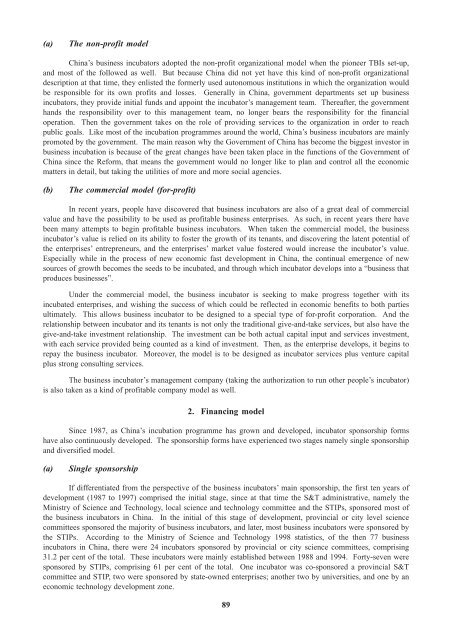iii. promoting business and technology incubation for ... - Escap
iii. promoting business and technology incubation for ... - Escap
iii. promoting business and technology incubation for ... - Escap
You also want an ePaper? Increase the reach of your titles
YUMPU automatically turns print PDFs into web optimized ePapers that Google loves.
(a)<br />
The non-profit model<br />
China’s <strong>business</strong> incubators adopted the non-profit organizational model when the pioneer TBIs set-up,<br />
<strong>and</strong> most of the followed as well. But because China did not yet have this kind of non-profit organizational<br />
description at that time, they enlisted the <strong>for</strong>merly used autonomous institutions in which the organization would<br />
be responsible <strong>for</strong> its own profits <strong>and</strong> losses. Generally in China, government departments set up <strong>business</strong><br />
incubators, they provide initial funds <strong>and</strong> appoint the incubator’s management team. Thereafter, the government<br />
h<strong>and</strong>s the responsibility over to this management team, no longer bears the responsibility <strong>for</strong> the financial<br />
operation. Then the government takes on the role of providing services to the organization in order to reach<br />
public goals. Like most of the <strong>incubation</strong> programmes around the world, China’s <strong>business</strong> incubators are mainly<br />
promoted by the government. The main reason why the Government of China has become the biggest investor in<br />
<strong>business</strong> <strong>incubation</strong> is because of the great changes have been taken place in the functions of the Government of<br />
China since the Re<strong>for</strong>m, that means the government would no longer like to plan <strong>and</strong> control all the economic<br />
matters in detail, but taking the utilities of more <strong>and</strong> more social agencies.<br />
(b)<br />
The commercial model (<strong>for</strong>-profit)<br />
In recent years, people have discovered that <strong>business</strong> incubators are also of a great deal of commercial<br />
value <strong>and</strong> have the possibility to be used as profitable <strong>business</strong> enterprises. As such, in recent years there have<br />
been many attempts to begin profitable <strong>business</strong> incubators. When taken the commercial model, the <strong>business</strong><br />
incubator’s value is relied on its ability to foster the growth of its tenants, <strong>and</strong> discovering the latent potential of<br />
the enterprises’ entrepreneurs, <strong>and</strong> the enterprises’ market value fostered would increase the incubator’s value.<br />
Especially while in the process of new economic fast development in China, the continual emergence of new<br />
sources of growth becomes the seeds to be incubated, <strong>and</strong> through which incubator develops into a “<strong>business</strong> that<br />
produces <strong>business</strong>es”.<br />
Under the commercial model, the <strong>business</strong> incubator is seeking to make progress together with its<br />
incubated enterprises, <strong>and</strong> wishing the success of which could be reflected in economic benefits to both parties<br />
ultimately. This allows <strong>business</strong> incubator to be designed to a special type of <strong>for</strong>-profit corporation. And the<br />
relationship between incubator <strong>and</strong> its tenants is not only the traditional give-<strong>and</strong>-take services, but also have the<br />
give-<strong>and</strong>-take investment relationship. The investment can be both actual capital input <strong>and</strong> services investment,<br />
with each service provided being counted as a kind of investment. Then, as the enterprise develops, it begins to<br />
repay the <strong>business</strong> incubator. Moreover, the model is to be designed as incubator services plus venture capital<br />
plus strong consulting services.<br />
The <strong>business</strong> incubator’s management company (taking the authorization to run other people’s incubator)<br />
is also taken as a kind of profitable company model as well.<br />
2. Financing model<br />
Since 1987, as China’s <strong>incubation</strong> programme has grown <strong>and</strong> developed, incubator sponsorship <strong>for</strong>ms<br />
have also continuously developed. The sponsorship <strong>for</strong>ms have experienced two stages namely single sponsorship<br />
<strong>and</strong> diversified model.<br />
(a)<br />
Single sponsorship<br />
If differentiated from the perspective of the <strong>business</strong> incubators’ main sponsorship, the first ten years of<br />
development (1987 to 1997) comprised the initial stage, since at that time the S&T administrative, namely the<br />
Ministry of Science <strong>and</strong> Technology, local science <strong>and</strong> <strong>technology</strong> committee <strong>and</strong> the STIPs, sponsored most of<br />
the <strong>business</strong> incubators in China. In the initial of this stage of development, provincial or city level science<br />
committees sponsored the majority of <strong>business</strong> incubators, <strong>and</strong> later, most <strong>business</strong> incubators were sponsored by<br />
the STIPs. According to the Ministry of Science <strong>and</strong> Technology 1998 statistics, of the then 77 <strong>business</strong><br />
incubators in China, there were 24 incubators sponsored by provincial or city science committees, comprising<br />
31.2 per cent of the total. These incubators were mainly established between 1988 <strong>and</strong> 1994. Forty-seven were<br />
sponsored by STIPs, comprising 61 per cent of the total. One incubator was co-sponsored a provincial S&T<br />
committee <strong>and</strong> STIP, two were sponsored by state-owned enterprises; another two by universities, <strong>and</strong> one by an<br />
economic <strong>technology</strong> development zone.<br />
89
















